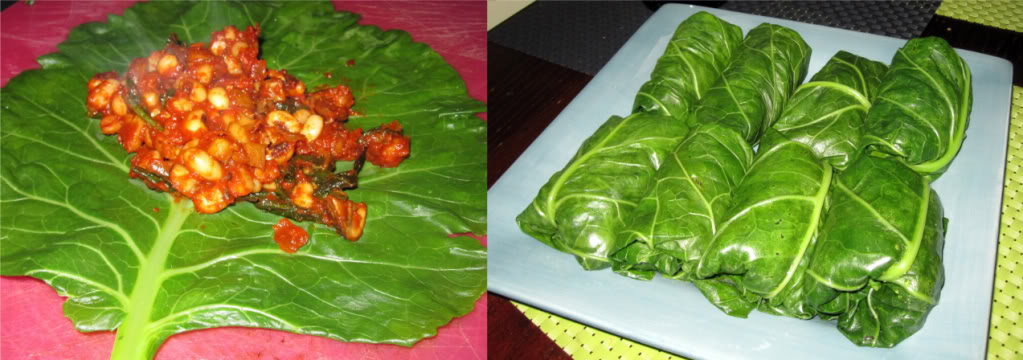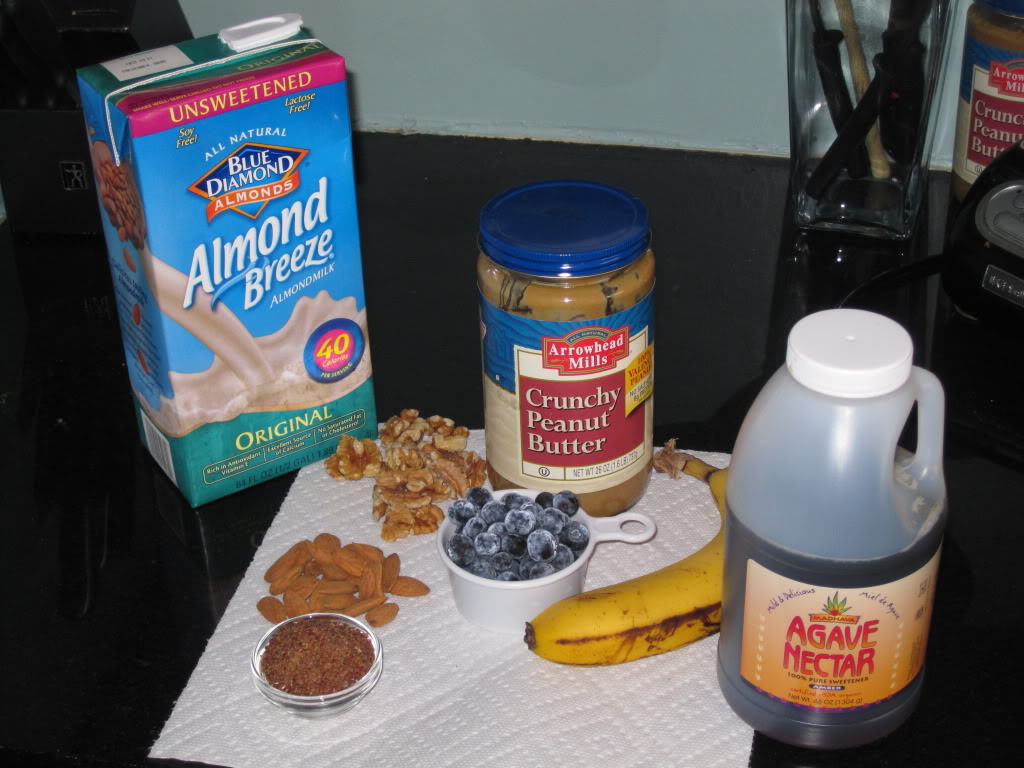Golden Rice with Curried Apricot Dressing
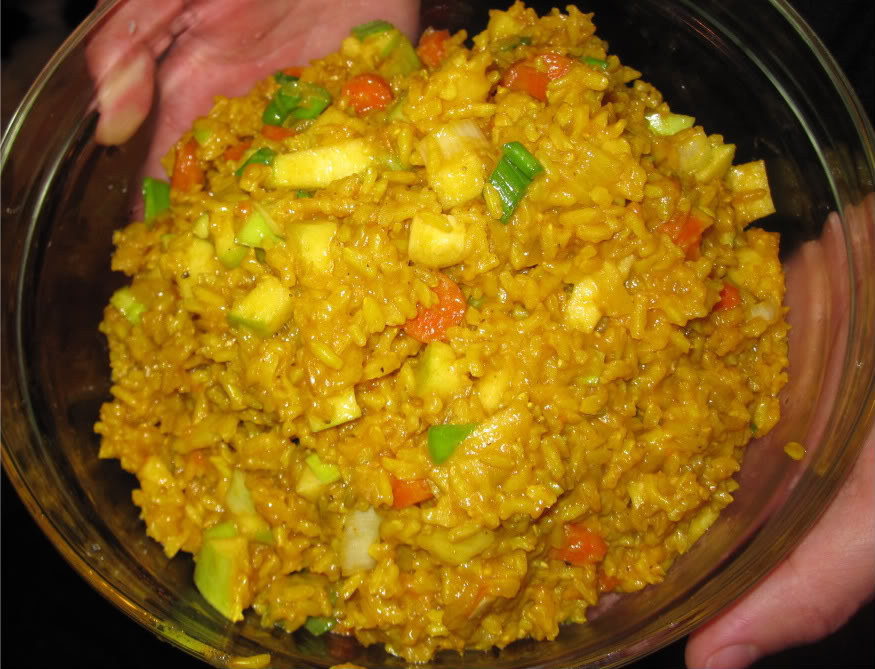
This dish is similar to paella but it has more sweetness in flavor. The apricot dressing is loaded with richness and spice, and makes the whole rice mixture really creamy. This recipe could easily satisfy 4 people, but keep in mind that before we started eating we were certain there would be leftovers but it was so good that we didn’t want to stop eating. But hey, that’s another great thing about eating a plant-based, whole foods diet– it’s all good-for-you stuff, so helping yourself to seconds (and thirds and fourths) is fine!
Update: I tried adding a can of chickpeas to this dish and really enjoyed it. It’s delicious either way, but I now prefer it with the chickpeas.
Ingredients:
1 tablespoon water or vegetable stock, for sauteing
1 medium sweet yellow onion, finely diced
2 cloves garlic, minced
1 teaspoon ground cumin
1 teaspoon fennel seed
1/4 teaspoon freshly ground pepper
1/2 teaspoon salt, or to taste
2 cups uncooked brown basmati rice
2 teaspoons turmeric
3 1/2 cups vegetable stock
3 large carrots, peeled and chopped
1 tart apple, diced and tossed with lemon juice
3 scallions, thinly sliced
Curried Apricot Dressing
1/4 cup apricot preserves
1/3 cup rice vinegar
1 tablespoon curry powder
1/4 teaspoon ground cardamom
1/4 teaspoon cayenne pepper
2/3 cup water
Instructions:
1. In a medium saucepan, heat the water or stock over medium heat and saute the onion and garlic until just softened, about 5 minutes.
2. Add the cumin, fennel seed, pepper, and salt. Saute for 1 minute.
3. Add the rice and stir constantly for 2 minutes or until the rice smells fragrant.
4. Add the turmeric and the 3 1/2 cups vegetable stock. bring to boil and cover.
5. Reduce heat to low and simmer for 40-45 minutes or until the liquid is absorbed.
6. Meanwhile, to make the dressing combine all the ingredients in a blender or food processor and blend until emulsified. Taste and adjust the seasonings.
7. After step 5 is done, remove the pan from heat and add the carrots, apple, and scallions. Stir so everything is all mixed in and then transfer to a large serving bowl.
8. Pour most of the dressing onto the rice and mix thoroughly. Taste and add the rest of the dressing, if desired, or reserve for another use. Serve, savor, and enjoy!
Source: This is based on a recipe from Colleen Patrick-Goudreau’s “Color Me Vegan”. (Her recipe calls for saffron, which I had planned to use but forgot to purchase. I used turmeric instead and we loved how it turned out so I’ll continue to make this dish with turmeric in the future. I also omitted the oil.)
Dillon Panthers Team BBQ Tofu
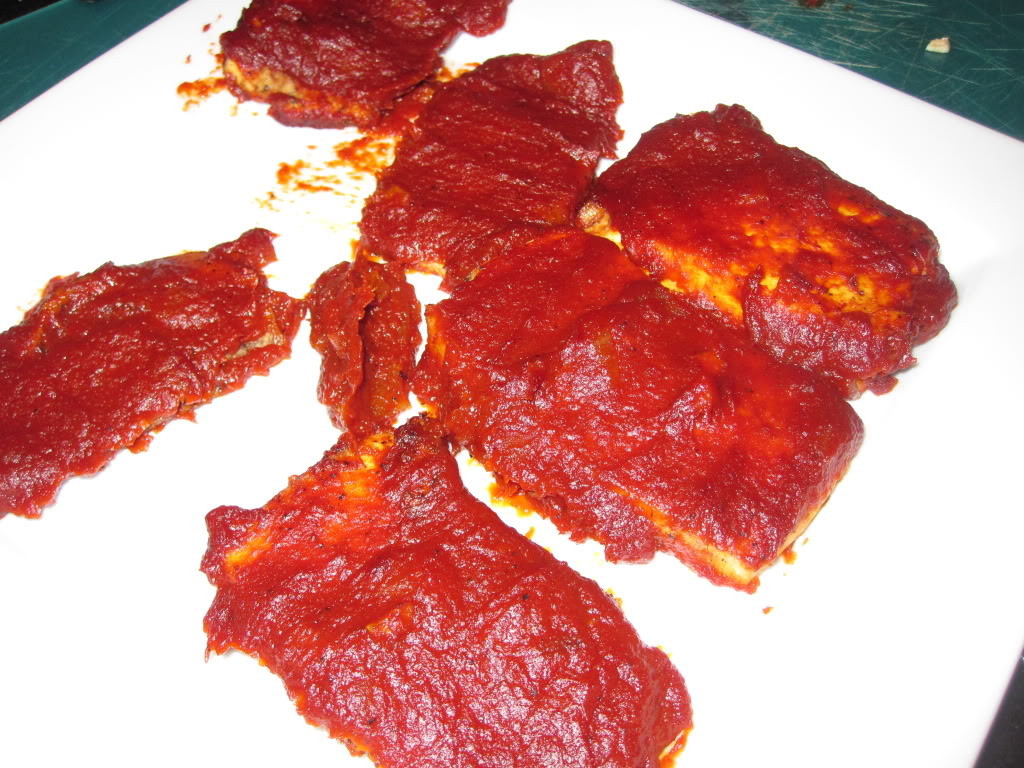
We recently completed the first four seasons of Friday Night Lights in less than a month and now the imaginary people of Dillon, Texas hold a big place in our hearts. If Tim Riggins had more sense he’d probably eat this sweet BBQ sauce on his tofu all the time.
Ingredients:
BBQ Sauce:
1 tablespoon vegetable broth or water
1 medium-size yellow onion, finely chopped
4 cloves garlic, minced
1/4 teaspoon salt
1 teaspoon red pepper flakes
1 (28 oz) can tomato paste
2/3 cup blackstrap molasses
1/3 cup white vinegar
1 tablespoon Dijon mustard
2 teaspoon liquid smoke
Tofu:
1 pound tofu, drained and pressed, cut widthwise into eighths
1 tablespoon reduced- sodium soy sauce or tamari
Ground pepper
Instructions:
1. Preheat a saucepan over medium heat. Place the onions in the pan and saute in broth until browned (5-7 minutes).
2. Add the garlic and saute for another minute.
3. Add all the other ingredients except the mustard and liquid smoke. Cook for 1 hour, uncovered, stirring occasionally. If the sauce starts to splatter, lower the heat.
4. Add the mustard and the liquid smoke, and taste for sweetness/sourness. Adjust if necessary, and cook for another 5 minutes.*
5. Preheat the oven to 350 degrees. Place tofu slices in a 9×18-inch (preferably glass or ceramic) baking pan. Drizzle with soy sauce and pepper, then flip the slices and do the same to the other side.
6. Bake for 15 minutes, then flip the slices and bake for another 15 minutes.
7. Remove from the oven and smother the slices with the BBQ sauce. Really let yourself go wild and lay it on thick! Return the pan to the oven and bake for another 15 minutes.
8. Remove from oven and serve.
(*Steps 1-4 can be done days in advance if you want. Just store the sauce in the fridge. Makes about 2 cups.)
Source: Inspired by recipes in “Veganomicon”
Why We Stopped Eating Dairy
That’s what we thought, too. But there is actually more suffering and death in a glass of milk than a piece of steak. This is because the veal industry is a byproduct of the dairy industry.
Cows are like all mammals in that they produce breast milk for their young. In order for a cow to produce milk, she must be pregnant and give birth. It’s funny how easily we forget this. We convince ourselves that cows just conveniently produce milk for the taking.
A dairy cow is constantly impregnated so that she will continue to produce milk. Her milk never reaches her baby, but is instead pumped out of her for human consumption. A cow is pregnant for 9 months. If she gives birth to a male, he is considered useless to the dairy industry. What happens to him? He is immediately taken from his mother and is sold and slaughtered as veal.
Cows form strong bonds with one another, particularly between mother and child. As Michael Klaper M.D. recalls: “The very saddest sound in all my memory was burned into my awareness at age five on my uncle’s dairy farm in Wisconsin. A cow had given birth to a beautiful male calf… On the second day after birth, my uncle took the calf from the mother and placed him in the veal pen in the barn– only ten yards away, in plain view of his mother. The mother cow could see her infant, smell him, hear him, but could not touch him, comfort him, or nurse him. The heartrending bellows that she poured forth– minute after minute, hour after hour, for five long days– were excruciating to listen to. They are the most poignant and painful auditory memories I carry in my brain.”
A dairy cow’s life is spent mourning the loss of baby after baby as she continues to be impregnated so humans can consume her milk. And she too is destined for the same horrific slaughter when her body has finally become too ravaged and overworked by constant pregnancy to continue producing milk.
We were slow to realize the direct connection between dairy products and the veal industry. But once it clicked, we were eager to stop consuming dairy. With all the dairy-free milks, cheeses, and yogurts out there, this was an incredibly easy change.
Why choose to contribute to such suffering when it’s so easy to make less harmful choices?
For a great list of commercially available non-dairy milks click here.
Also, see my post about why you don’t need cow’s milk for calcium here.
And go to my FAQ section for advice how to transition off dairy.
Basil-Cilantro Pesto

Robert and I agree that this basil-cilantro pesto is the best pesto we’ve ever tasted. It’s lemony and bright, and because it uses almonds in place of cheese, the texture is has just the right amount of creaminess. We enjoyed it with cannellini beans, but it would also be great on pasta, baguettes, or anything else you enjoy eating with pesto. This recipe makes about 1 cup.
Ingredients:
2 cups loosely packed fresh basil leaves
1 cup loosely packed fresh cilantro
1/3 cup almonds
2 cloves garlic
1/4 cup lemon juice
1/2 teaspoon salt
1/4 cup water (if necessary)
Instructions:
1. Place the basil, cilantro, almonds, garlic, lemon juice, and salt in a food processor. Blend till pasty, scraping down the sides occasionally.
2. Add the water if necessary and blend till smooth. Yum!
We’re All Cookie Monsters!
1 3/4 cup oat flour
1/2 teaspoon baking powder
1/4 cup white sugar
1/2 cup brown sugar
1/3 cup organic canola oil
1 tablespoon ground flax seeds or flax meal
1/4 cup almond milk (or soy is fine)
1 teaspoon vanilla
3/4 cup dark chocolate chips
Instructions:
1. Preheat oven to 375 degrees.
2. In a bowl add oat flour and baking soda and whisk. Add the flax, almond milk, sugars and stir. Add canola and vanilla and whisk vigorously for about 1-2 minute.
3. Fold in chocolate chips.
4. Drop batter by the tablespoon onto an ungreased baking sheet, leaving 1 1/2 inch between cookies. Stick ’em in the oven.
5. Remove from oven after 10-12 minutes. Let cool for 5 minutes and then remove with a spatula and put them on a cooling rack.
Source: Inspired by a recipe in Veganomicon by Isa Chandra Moskowitz and Terry Hope Romero. Their recipe called for more white sugar than brown sugar, but I prefer to use more brown sugar than white sugar.
Robert’s Power Breakfast! (And, Why You Don’t Need Cow’s Milk for … Anything!)
Brussels Sprouts + Apples + Pecans
Brussels Sprouts are so cute! They are also really nutritious, boasting high amounts of vitamins C and K, and containing an abundance of disease-fighting phytochemicals, including sulforaphane, which helps rid the body of carcinogenic substances.
This dish was inspired by a recipe in “Color Me Vegan” by Colleen Patrick-Goudreau. I absolutely LOVE this cookbook and I think the author is awesome. Her podcast Vegetarian Food for Thought (which you can listen to for free) is so inspiring and informative. Not only is she well-versed in nutrition–which is why I started listening to her in the first place–but she also has helped me see that our food choices can be, and should be, an extension of who we are and what we value in life. It’s such an empowering outlook. Her words have really broadened my perspective.
Ingredients:
2 pounds Brussels sprouts, washed and shredded (cut into strips)
2 tablespoons vegetable broth
1 large tart apple, unpeeled and cubed
3 medium garlic cloves, minced
1 tablespoon pomegranate syrup (if you can’t find that, use maple syrup)
1/3 cup pecans, toasted and chopped
Salt and pepper, to taste
Instructions:
1. In a large saute pan, heat broth over medium heat. Add the shredded Brussels sprouts and a touch of salt and saute for 7-10 minutes until the sprouts begin to brighten.
2. Add the apple cubes, garlic, and syrup, and cook for 3-5 minutes or until the apples are heated through but not too soft.
3. At the end of the cooking time, add the pecans, and salt and pepper to taste.
Follow Up: The Truth About Chicken + Cholesterol
Asking questions and examining some of our assumptions about food is in the best interest for ourselves and the ones we love.
Thanks for reading.
Baingan Bharta (Indian-Style Eggplant) + Garbanzos
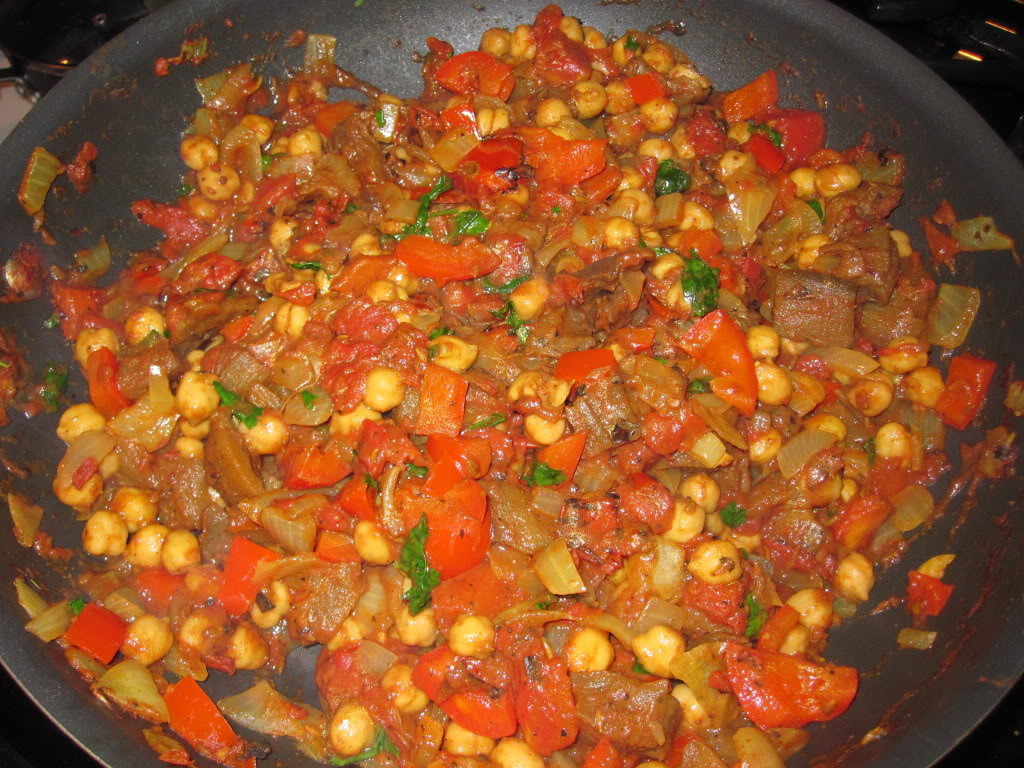
1. Preheat oven to 400 degrees. Prick eggplant with a fork several times and place on a baking sheet. Bake for 45 minutes. Remove from oven and set aside until cool enough to handle. Peel and chop the eggplant.
Sources:
http://www.whfoods.com/genpage.php?tname=foodspice&dbid=22, http://www.manjulaskitchen.com/2009/10/09/baingan-bharta-eggplant/

